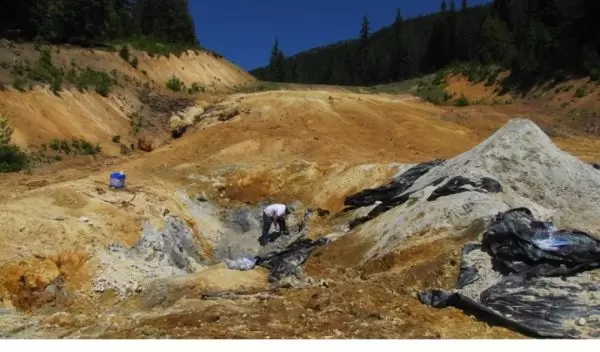
Scientists discover how blue and green clays kill bacteria
Since prehistoric times, humans have used clays for medicinal purposes.
Whether through ingestion, mud baths or as a way to stop bleeding from wounds, clay has long helped keep humans healthy. Scientists have found that certain clays possess germ-killing abilities, but how these work has remained unclear.
A new discovery by Arizona State University (ASU) scientists shows that two specific metallic elements in the right kinds of clay can kill disease-causing bacteria that infect humans and animals.
"The novelty of this research is two-fold: identifying the natural environment of the formation of clays toxic to bacteria, and how the chemistry of these clays attacks and destroys the bacteria," says Enriqueta Barrera, a program director in the National Science Foundation (NSF) Division of Earth Sciences, which funded the research. "This geochemical mechanism can be used to develop products that act on bacteria resistant to antibiotic treatment."
An antibacterial Trojan horse
"We think of this mechanism like the Trojan horse attack in ancient Greece," says Lynda Williams, a clay-mineral scientist at ASU. "Two elements in the clay work in tandem to kill bacteria."
She explains that "one metallic element -- chemically reduced iron, which in small amounts is required by a bacterial cell for nutrition -- tricks the cell into opening its wall. Then another element, aluminum, props the cell wall open, allowing a flood of iron to enter the cell. This overabundance of iron then poisons the cell, killing it as the reduced iron becomes oxidized."
Adds scientist Keith Morrison of the Lawrence Livermore National Laboratory, "It's like putting a nail in the coffin of the dead bacteria."
Morrison is the lead author of a paper reporting the discovery, published today in the journal Nature Scientific Reports. Williams and Rajeev Misra, a microbiologist at ASU, are co-authors.
From French green clay to Oregon blue clay
A chance discovery of a medicinal clay from Europe caught Williams' attention and put her on track for the recent discovery. Line Brunet de Courssou, a philanthropist with clinical medicine experience in Africa, passed along information about a particular green-hued clay found near her childhood home in France.
Brunet de Courssou had taken samples of the clay to Africa, where she documented its ability to cure Buruli ulcer, a flesh-eating skin disease, for patients in Ivory Coast.
Williams attempted to locate the site of the green clay deposit in the French Massif Central region. When the search proved unsuccessful, she began systematically testing clays sold online as "healing clays."
After analyzing dozens of samples, Williams and her team identified a blue-colored clay from the Oregon Cascades that proved to be highly antibacterial.
The research shows that it works against a broad spectrum of human pathogens, including antibiotic-resistant strains such as methicillin-resistant Staphylococcus aureus (MRSA).
The colors of the clays reflect their origins, Williams says.
Greens and blues are antibacterial clues
The greens and blues of antibacterial clays come from having a high content of chemically reduced iron, as opposed to oxidized iron, which provides the familiar rust color associated with many clays.
Such "reduced" clays are common in many parts of the world, typically forming in volcanic ash layers as rocks become altered by water that is oxygen-deprived and hydrogen-rich.
Because blue and green clays abound in nature, Williams says, the discovery of how their antibacterial action works should lead to alternative ways of treating persistent infections and diseases that are difficult to treat with antibiotics.
"Finding out how natural clays kill human pathogens," she says, "may lead to new economic uses of such clays and to new drug designs."
Part of the investigation involved the use of the NSF-supported Secondary Ion Mass Spectrometry Facility.
